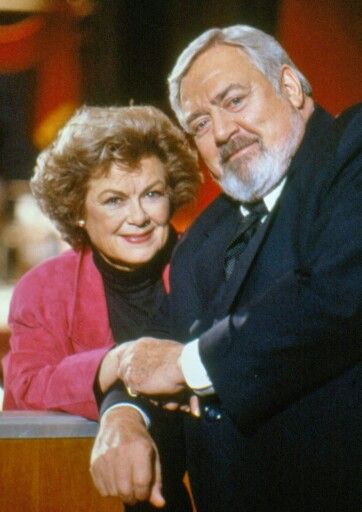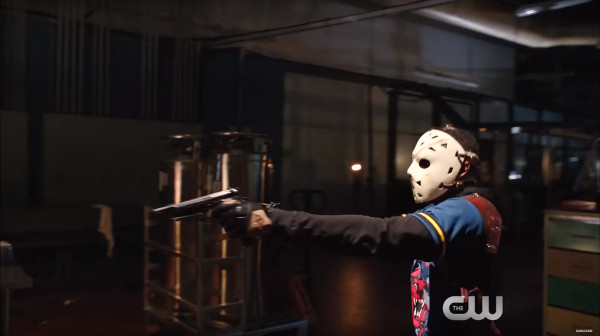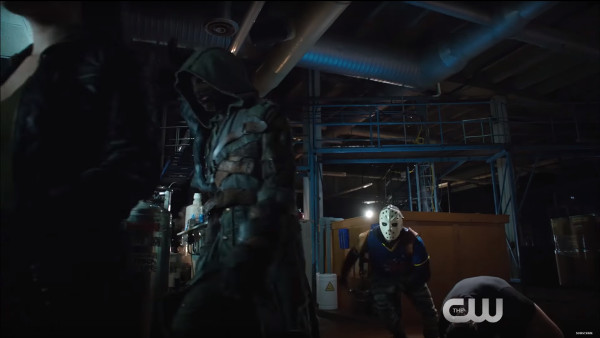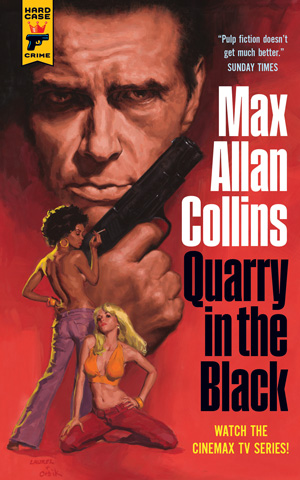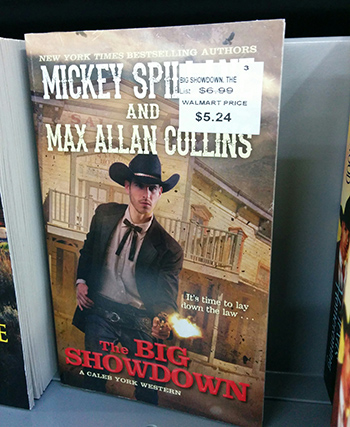
The picture was taken at the Muscatine, Iowa, Wal-Mart, showing the paperback edition of The Big Showdown for sale on its shelves. This, my friends, is truly the big time. I haven’t spotted a book of mine here since the heyday of the CSI tie-ins.
I’d had reports of sightings of The Legend of Caleb York at Wal-Marts here and there around the USA, but it didn’t make it to my hometown, where the book area is fairly modest. Romances make up the biggest number of titles, but westerns are also a staple. Mysteries/thrillers of mine don’t make the cut.
While the new Mike Hammer novels, and the several non-Hammer Hard Case Crime posthumous Spillane titles, have all done modestly well, the success of Spillane as a western byline might just have more impact. And Wal-Mart is a big part of that, because they are one of the few book outlets that support Westerns, big time.
And the Spillane byline has real resonance with the older audience that buys Westerns. Not all Western readers are Baby Boomers like me, who recognize the name of the bestselling fiction writer of the 20th Century. But a good share are. Mickey’s friend Louis L’Amour, who died in 1988, is still one of the top names in the Western field.
Mickey, of course, viewed Mike Hammer as a Western-style hero moved to the urban frontier. He often said that Hammer “wore the black hat,” but was a good guy nonetheless.
Though I’ve been a fan of Western movies and TV since childhood – what Baby Boomer male wasn’t? – I never considered writing a Western novel. I’ve only read a handful in my life. But one of my earliest obsessions was the Maverick TV show, and a good deal of Bret Maverick got into Nate Heller. And I watched all those shows – Bat Masterson, The Life and Legend of Wyatt Earp, Gunsmoke (when it was thirty minutes), Yancy Derringer and so many more.
And some of my favorite films are westerns – The Searchers, Ride the High Country, Rio Bravo, Red River, The Tall T, Comanche Station, Ride Lonesome, Seven Men from Now, and The Good, the Bad, and the Ugly. My character Nolan drew from the Italian westerns of Lee Van Cleef – The Big Gundown, Death Rides a Horse, For a Few Dollars More.
So maybe it was inevitable that, before I rode off into the sunset, I’d be writing some Westerns. I had already written the novelization of the movie version of Maverick and the Wyatt Earp Meets Al Capone novel, Black Hats (new edition coming from Brash Books).
Plus the unproduced screenplay of Mickey’s that started it all, The Saga of Calli York, was written for his pal John Wayne. (“Calli” a now inappropriate nickname for “Caleb,” the former dropped from the books.) You’ll note quite a few Wayne titles among those listed above. I had only intended to write the one book, novelizing that screenplay, but my editor at Kensington Books insisted on three novels. And now I’ve signed to do two more.
This marks the first time Mickey’s byline appears with mine on books to which he didn’t contribute any writing. But the Caleb York yarns use his characters and situations and are a legitimate extension of the vision he developed in the screenplay – a winning combination of the Western myth of those John Wayne and Randolph Scott westerns and a more violent, pre-Leone approach.
The sex is there, too, but somewhat soft-pedaled. Apparently Wal-Mart will go for the tough stuff, but nothing smutty. Maybe that’s why Nate Heller never made it on their shelves….
I had a fun e-mail from my old pal Steve Noah that I’d like to share with you.
Am in Kigali, Rwanda at 1:20 AM finishing EXECUTIVE ORDER and thought you might be interested to know that the clever lighting of the Washington Monument you mention on page 233 was provided by Musco Sports Lighting, with ties to Muscatine.
Best,
Steve”
My thanks to Steve for this fascinating info.
Musco is a very famous lighting company, much used in big-time sports and by Hollywood. The “Musc,” as you may have figured out, stands for Muscatine, the river town of 23,000 where Barb and I have always lived.
The Musco operation is adjacent to the junk yard where the climax of my movie Mommy was shot in 1994. They provided the lighting. I often joke that they just turned their lighting trucks around and pointed them our way, but really they did much more than that.
I’m honored that this incredibly famous company supported my small filmmaking endeavor.
Wild Dog is a regular on Arrow, now. Still haven’t seen any episodes. I’ll watch when I receive a check.
M.A.C.
